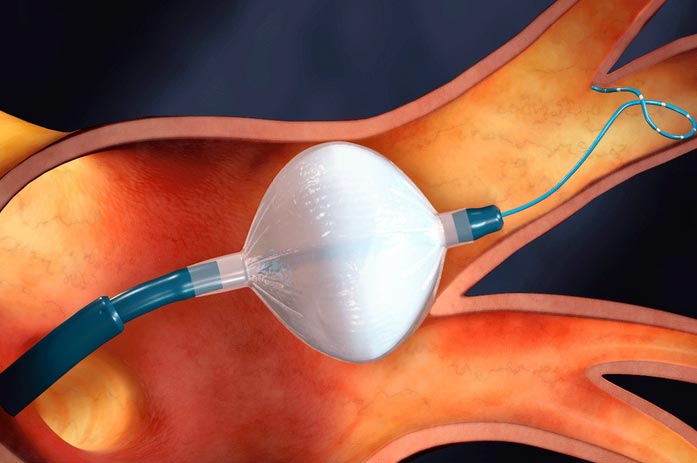Rethink how we treat atrial fibrillation

Cryoablation involves guiding a small tube into the heart and inflating a small balloon to kill problematic tissue with cold temperatures.
Credit: Medtronic
National study suggests it’s time to rethink how we treat atrial fibrillation.
Early intervention with catheter cryoablation can halt disease progression, reduce risk of serious health impacts.
A national study led by UBC researchers at the Centre for Cardiovascular Innovation is shedding light on how to more effectively treat atrial fibrillation (AF) – a common heart rhythm problem associated with increased risk of stroke and heart failure.
The study, published today in The New England Journal of Medicine, shows that early intervention with cryoballoon catheter ablation (cryoablation) is more effective at reducing the risk of serious long-term health impacts, when compared to the current first step in treatment, antiarrhythmic drugs.
“By treating patients with cryoablation right from the start, we see fewer people advancing to persistent, more life-threatening forms of atrial fibrillation,” says Dr. Jason Andrade, an associate professor of medicine at UBC and director of Heart Rhythm Services at Vancouver General Hospital. “In the short term, this can mean less recurrences of arrhythmia, improved quality of life and fewer visits to the hospital. In the long run, this can translate into a reduced risk of stroke and other serious heart problems.”
Cryoablation is a minimally invasive procedure that involves guiding a small tube into the heart to kill problematic tissue with cold temperatures. Historically, the procedure has been reserved as a secondary treatment when patients don’t respond to antiarrhythmic drugs.
“This study adds to the growing body of evidence that early intervention with cryoablation may be a more effective initial therapy in the appropriate patients,” says Dr. Andrade.
Early intervention halts disease progression
AF affects approximately three per cent of the population, or more than one million Canadians.
While the condition starts as an isolated electrical disorder, each recurring incident can cause electrical and structural changes in the heart that can lead to longer-lasting events known as persistent AF (episodes lasting more than seven continuous days).
“Atrial fibrillation is like a snowball rolling down a hill. With each atrial fibrillation episode there are progressive changes in the heart, and the heart rhythm problem gets worse,” explains Dr. Andrade.
The new findings, stemming from a multi-site clinical trial, show that cryoablation can stop this snowball effect.
For the trial, the pan-Canadian research team enrolled 303 patients with AF at 18 sites across Canada. Half of the patients were randomly selected to receive antiarrhythmic drugs, while the other half were treated with cryoablation. All patients received an implantable monitoring device that recorded their cardiac activity throughout the study period.
After three years, the researchers found that patients in the cryoablation group were less likely to progress to persistent AF compared to patients treated with antiarrhythmic drugs. Over the follow-up period, the cryoablation patients also had lower rates of hospitalization and experienced fewer serious adverse health events that resulted in death, functional disability or prolonged hospitalization.
Addressing the root cause
Because cryoablation targets and destroys the cells that initiate and perpetuate AF, the researchers say it can lead to longer-lasting benefits.
“With cryoablation, we’re treating the cause of the condition, instead of using medications to cover-up the symptoms,” says Dr. Andrade. “If we start with cryoablation, we may be able to fix atrial fibrillation early in its course.”
The new study builds on a previous paper in which Dr. Andrade and his team demonstrated that cryoablation was more effective than antiarrhythmic drugs at reducing the short-term recurrence of atrial fibrillation.
The researchers say that more effective early interventions would benefit patients as well as the health care system. Currently, costs associated with the provision of atrial fibrillation-associated care are estimated at 2.5 per cent of overall annual health care expenditures. Those costs are expected to rise to four per cent within the next two decades.
“The evidence shows increasingly that it’s time to rethink how we approach the treatment of atrial fibrillation. With effective early intervention, we can keep people healthy, happy, and out of hospital, which would be a tremendous benefit for patients and their families, and also our entire health system.”
Journal: New England Journal of Medicine
DOI: 10.1056/NEJMoa2212540
Method of Research: Randomized controlled/clinical trial
Subject of Research: People
Article Title: Progression of Atrial Fibrillation after Cryoablation or Drug Therapy
Article Publication Date: 7-Nov-2022
COI Statement: https://www.nejm.org/doi/suppl/10.1056/NEJMoa2212540/suppl_file/nejmoa2212540_disclosures.pdf
Media Contact
Brett Goldhawk
UBC Faculty of Medicine
brett.goldhawk@ubc.ca
Cell: 778-952-7858
@@UBCMedicine
All latest news from the category: Medical Engineering
The development of medical equipment, products and technical procedures is characterized by high research and development costs in a variety of fields related to the study of human medicine.
innovations-report provides informative and stimulating reports and articles on topics ranging from imaging processes, cell and tissue techniques, optical techniques, implants, orthopedic aids, clinical and medical office equipment, dialysis systems and x-ray/radiation monitoring devices to endoscopy, ultrasound, surgical techniques, and dental materials.
Newest articles

NTU and NUS spin-off cutting-edge quantum control technology
AQSolotl’s quantum controller is designed to be adaptable, scalable and cost-efficient. Quantum technology jointly developed at Nanyang Technological University, Singapore (NTU Singapore) and National University of Singapore (NUS) has now…

How Geothermal Energy Shapes Bavaria’s Green Future Through Sustainable Energy
The Bavarian State Ministry of Science and the Arts has extended its funding for the research association “Geothermal Alliance Bavaria,” with the University of Bayreuth (UBT) continuing as a member…

Spintronics memory innovation: A new perpendicular magnetized film
Long gone are the days where all our data could fit on a two-megabyte floppy disk. In today’s information-based society, the increasing volume of information being handled demands that we…



